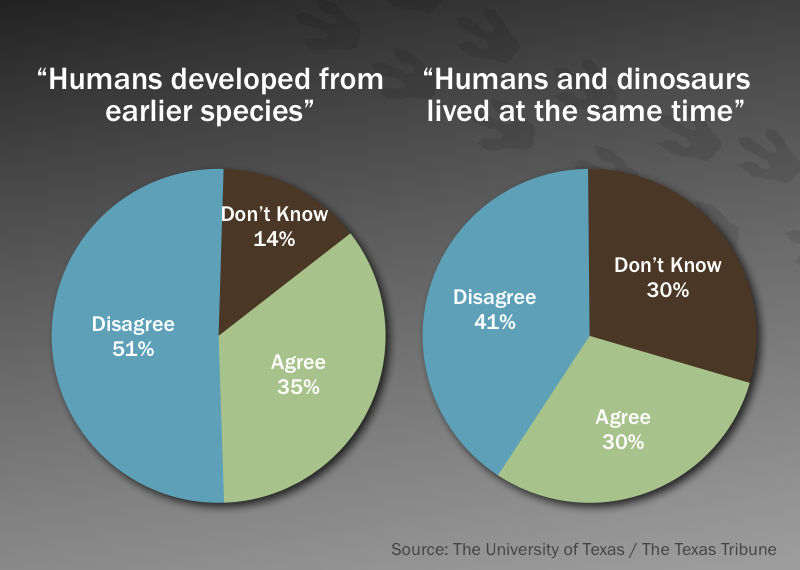
This is from a poll of Texans and you can read the writeup here. To me, these charts are a wonderful explanation of why discussions about science and faith can become quite heated. Usually, these arguments begin because the people are not focused on who has the "correct" answer. Instead, they are arguing over whose beliefs are "correct".
So let's examine this thing we call "belief" and where it comes from.
As humans, we absorb knowledge, beliefs and ideals from all kinds of information sources, but certain influences carry more weight than others. So how do we decide whether or not to believe new information when it is presented?
I have a one-word answer to that question: Trust.
Advertisers will tell you that repetition forms beliefs, and while that may be true to a degree, our core beliefs are born from trust. If you trust a source, you will be more likely to accept it and incorporate it into your beliefs. If you question the source, you will be more likely to look to other sources for confirmation. Essentially, whether or not you believe your parents, your religious leaders, your professors, Wikipedia, CNN, NBC, FOX, Obama, Bush, OJ Simpson, Bono from U2, or even yourself is all based on who you trust. It makes little difference if the source is "correct".
This is why humans find it so difficult to change their core beliefs. Changing your core beliefs requires you to acknowledge that previously trusted sources may have been incorrect. Then, you must do something that seems extremely unnatural... you must remove any previous feelings of trust and examine the information on your own, free of outside influences. Not easy to do.
To prove my point, let's do a little exercise:
If you know me, then you know that I'm a graduate student studying earthquakes. So if I was to write a blog telling you that large earthquakes are becoming more and more frequent, you would probably believe me and not question the source, right?
This is because (1) you trust me and (2) a theory about increasing earthquake activity would be supported by what you heard about earthquakes in Haiti and Chile, right?
Well, the truth is that earthquakes are not becoming more and more frequent. If you trust the USGS, you can read this FAQ, which explains why earthquake activity is not increasing and what causes this common misconception.
If you don't trust the USGS, I just spent 10 minutes downloading data and plotting it in Excel:

Regardless of who you believe, I hope I've made the point that belief does not necessarily equal truth.
This blog was kind of a preface, and I hope it will prepare you to be challenged in future posts. As I move forward, I hope you will be able to look beyond your beliefs and seek the truth. But don't believe something is true just because you read it on the Internet. Believe it because you have examined it on your own and accepted its truth free of outside influence.

In regards to the chart that you posted, I would like to get your take on the often not talked about evidence that dinosaurs and humans coexisted from the sets of both fossilized dinosaur and human foot prints found in Texas. It's called the Taylor Trail and there are several other sets of prints like it found in various places.
ReplyDeletehttp://www.bible.ca/tracks/tracks.htm
Thanks for the comment!
ReplyDeleteI probably should do a write up on these tracks, but I'm not exactly an expert on them. Maybe I'll bump this topic up in my queue.
For now, I'll defer to the link on the side of my page for Glen Kuban's Paleo Site (http://paleo.cc/paluxy.htm), which is an awesome resource for trackways and lots of other stuff. That's where I found the article about the shark I mentioned in my "About the Author" post.
Glen's page has a very detailed, first-hand narrative specifically about the Taylor site (http://paleo.cc/paluxy/tsite.htm), complete with references, diagrams and photos.
I also found an article by the guys at the Institue for Creation Research that basically says the tracks are inconclusive at best (http://www.icr.org/article/paluxy-river-mystery/). I don't really agree with much from this group, but I thought I'd provide the link anyways.
I love the charts.
ReplyDelete...but are the charts to six sigma quality?
ReplyDeleteHave you ever read Plato's Allegory of the Cave? It talks about trust and what to believe. I think you'll find it interesting.
ReplyDeletehttp://faculty.washington.edu/smcohen/320/cave.htm
Actually, this is a better link and has a video:
ReplyDeletehttp://platosallegory.com/
Thanks for those links! That second claymation movie is great.
ReplyDelete